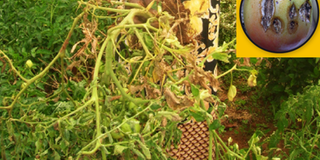Prime
Tomato bacterial wilt strikes again

AT A LOSS: Ms Milly Muwonge displays a tomato plant infected with bacterial wilt. The disease is most prevalent in tropical regions like Uganda. PHOTO BY JOSEPH MITI.
Milly Muwonge looked on in despair as part of her flowering tomato plantation started to wither away. She tried to spray the tomatoes with pesticides, but the more she sprayed, the more the plantation dried up.
“I cannot tell what has happened to my plantation. I don’t know what kind of disease this is,” Ms Muwonge, a resident of Ntaawo in Mukono District, said as she uprooted one of the affected plants. “I don’t know what to do now because it seems I will lose the whole plantation,” she added.
However, Godfrey Sseruwu, a research officer at Mukono Zonal Agricultural Research Institute (Muzardi), identified the disease as tomato bacterial wilt. He said the disease is caused by a soil-borne bacterium, Ralstonia Solanacearum, which cannot be controlled by spraying.
Mr Sseruwu said the disease is currently a great threat to tomatoes mostly in the central and eastern regions of Uganda. “The disease affects the roots. It causes the roots to rot and after decomposing, the plant fails to take in water that enables it to manufacture food, ending up wilting,” he said. It affects the plant at the flowering stage and it wilts within four to five days, he added.
Symptoms
First, wilting appears on the youngest leaves of the plants during hot daytime temperatures. The infected plants may recover, temporarily, in the evening when temperatures are cooler. But a few days later, a sudden and permanent wilt occurs, Mr Sseruwu says.
He says at times the lower leaves will turn yellow before wilting symptoms occur and in the early stages of disease development, the vascular system appears yellow or dark brown. “The bacterium can survive in soil for extended periods, so farmers should target free infection soil. Once you know that the soils were once affected, don’t plant tomatoes there,” he advises. He adds, “Whenever you see an affected plant, remove it immediately and burn it.”
Sseruwu says farmers can also use tolerant varieties like the Tangeru 97 variety, which is currently being evaluated by researchers at Muzardi. According to him, the variety can be affected but not as much as other common varieties.
Tomatoes are the most popular vegetable used by almost everybody, daily. Their popularity makes them dominate home gardens since they are easy to be grown compared to other vegetables. But tomatoes can suffer from all kinds of diseases and pests. Problems experienced in growing tomatoes are often the result of weather conditions, which is out of farmers’ control. However, if you know your area is prone to a certain disease, you should look for varieties that are listed as ‘‘resistant’’, Mr Seruwu says. Farmers ought to seek advice from extension service workers when they spot any type of disease, he adds.




